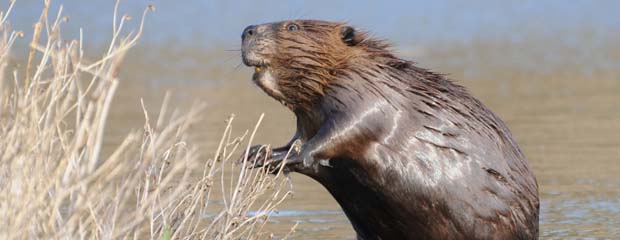MARS Moment April 2011
by Sandy Fairfield, MARS Education Coordinator
Canada’s national animal emblem is an environmental engineer second only to man in its ability to change a landscape to suit its own needs.
During the early settlement of North America, the Beaver became symbolic to many companies including the Hudson Bay Company and the Canadian National Railway and was featured on the first Canadian stamp; its image still resides on the obverse side of the Canadian nickel.
Beavers are the largest semi-aquatic rodent in North America. It was estimated there were over six million beavers in the 1600s, but by the end of the 1700s they were almost extinct. Beavers were hunted and trapped relentlessly, fuelled by the demands of the European fashion industry to supply quality fur for top hats, the latest vogue.
Easily recognizable with their large flat tails and protruding front teeth, the North American Beaver is found across Canada and the United States, with the exception of Florida and most of California.
Weighing between 20 and 35 kilos, they stand 30 centimetres tall and are 25 centimetres long. They have dense brown fur, wide heads with small rounded ears, powerful jaws, and large upper front teeth with gnawing bottom teeth which are all renewable and self-sharpening.
Because Beavers have to construct under water, they have loose lips which they draw together behind their front teeth, making their mouths watertight; they also have transparent eyelids and the ability to close their nose and ear openings when submerged. A Beaver’s hind feet are clawed and webbed; the front legs have fingers and claws which they use to hold food and strip bark from wood.
One of their most active features is their tail: it acts as a rudder when they swim or build; is used as a prop when foraging for branches, enabling them to stand up to work; as a lever to help them drag branches into position; and as a “noise maker” when threatened ~ Beavers raise the alarm by slapping their tails on the water.
Beavers need to live near water: rivers, streams, ponds or lakes. They are one of the few creatures that create a perfect habitat for themselves, altering their environment to provide space and protection.
Dams and canals are built to change the course of streams, forcing the water to back up to create shallow ponds where they construct their domed “lodge.” Dams are built with sticks and deciduous tree bark and held together with mud to plug the holes; lodges are built with sticks, branches and tree trunks from birch, aspen, willow, alder and cottonwood ~ all felled by the Beaver’s sharp teeth. The presence of pointed tree stumps is a good indication that Beavers are active in an area.
Lodges are often built in the middle of shallow ponds; underwater entrances’ with tunnels lead to dry inside chambers. Foods and nesting materials are stored in the lodge allowing Beavers to remain self-sufficient even if the pond freezes. As with all nature there are some exceptions: where the water is too fast-flowing to construct a dam, Beavers will create burrows in river banks.
Aquatic plants, including water lilies and cattails, are staple foods of the Beaver; they are especially partial to the soft tissue, wood and bark of hardwood trees.
Beavers are monogamous: a mated pair will produce two to four kits each year between April and June. They stay together as a family until the kits reach adulthood, around their second winter. They then leave home, find a mate and build their own dams and lodges.
These highly industrious, gentle creatures are preyed upon by foxes, wolves and otters; the young sometimes fall prey to raptors. Unfortunately humans are a big threat to their environment ~ particularly when Beaver dams flood residential areas ~ and unleashed dogs are always a threat to wildlife.
Two weeks ago MARS rescued a Beaver that was attacked by a dog in a local park. Apart from being traumatized and sustaining superficial injuries to her tail, the Beaver was not badly hurt. She was cared for and stabilized at our Wildlife Centre before being flown by MARS’ Transportation Volunteer, Norm Snihur, via helicopter to Critter Care in Langley, where they specialize in mammal rehabilitation.
If Beavers are a problem in your area you could try installing wire mesh in a ring around tree trunks (four to five feet from the ground up): this prevents Beavers from gnawing the trunks and has been successfully used at a local golf course.
Baby wildlife season is fast approaching and again we remind people to leave wildlife alone: watch from a distance and call our Centre before intervening. The best chance of survival for baby creatures is with their parents and too often they are “kidnapped” as the parents watch from their hiding places.
To report injured or orphaned wildlife, call toll-free: 1-800-304-9968; for all other calls: 250-337-2021.

